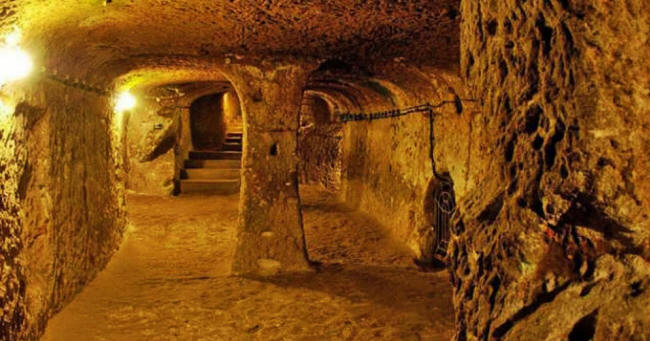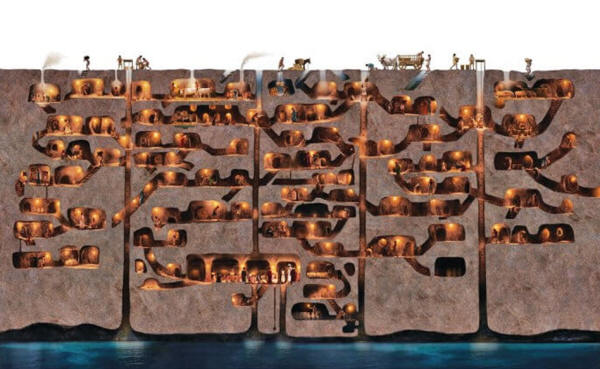|
by Robert M. Schoch Sept/Oct 2012 - #95 from AatlantisRisingMagazine Website
host Survivors of a
concluding Ice
Age...?
Perhaps this sounds like a scene out of a Cold War scenario where something went terribly wrong, resulting in a nuclear attack.
However, this is not fantasy, but a realistic account of what may have occurred thousands of years ago. To piece together precisely the history of the remote past, we need to examine multiple lines of evidence around the world.
One key piece of the
puzzle is found in central Turkey, in the region known as
Cappadocia.
Formed of volcanic rocks (tuffs or tufa) spewed out millions of years ago by local volcanoes, the terrain has eroded into an incredible topography consisting of steep valleys, ridges, and odd formations including columns often topped with harder rock, known colloquially as "fairy chimneys."
What is more, the volcanic tuffs are relatively easily dug into, carved, and excavated; this has served the people of the region well - and I believe has saved many a life when catastrophe hit.
It can be argued that
this was one of the outposts or refuges that allowed humanity to
survive and reemerge, literally, from below the ground. For in
Cappadocia are found not just dwellings and churches carved into the
sides of hills and rock cliffs, but entire ancient underground
cities.
Two of the best known are Kaymakli and Derinkuyu, portions of which are open to the public.
To this day nobody really knows the true extent of these or other underground cities of the area, but they were substantial.
And the underground cities may not have been entirely isolated from one another.
Kaymakli and Derinkuyu are less than a dozen kilometers (seven-and-a-half miles) from each other, and there are reports of a tunnel that may connect them.
Each underground city includes all of the necessities to support its inhabitants.
In some cases each level appears to have been able to function as an independent unit. There are living quarters for both humans and beasts, the barns and animal stalls being generally located near the entrances.
There are storage areas, wineries, kitchens, dining rooms, bedrooms, schools, and churches complete with naves, altars, and seating platforms for the congregation.
There are also specialty areas, such as a room at Kaymakli containing a huge, round platform of igneous rock, with dozens of depressions carved into the top, which may have been used for melting, refining, and working copper.
The underground cities are entered via narrow passageways; and similar narrow passageways, so tight that it can be difficult to squeeze through, connect different areas and levels.
The passages could be blocked, thus protecting the inhabitants inside, with huge round stone "doors" (in the range of one or two meters [3.3 to 6.6 feet] in diameter, a half meter [1.6 feet] thick, and weighing around 500 kilograms [1100 pounds]) that could be easily wheeled into place (or opened again) from the inside but not from the outside.
Clearly these underground cities with their narrow passages and protective barriers served as some kind of fortifications or protective refuges, but,
The standard archaeological answers to these questions are fairly straightforward and make some sense, at least superficially.
There is plenty of evidence that various underground cities were occupied during Greek and Roman times and into the early Christian and Byzantine period. In particular Byzantine churches carved into the rocks abound, many dating to the tenth through thirteenth centuries, but this is late in the history of Cappadocia.
Most historians concede that underground cities were used earlier, possibly during the period of the Hittite Empire, which controlled the region from about the eighteenth century BC to the twelfth century BC (with so-called Neo-Hittite peoples surviving until about 700 BC).
Furthermore, the standard view is that people did not necessarily live underground continuously, but rather retreated underground when enemies invaded their lands.
A question that remains unresolved, if this scenario is true, is how exactly the people underground could survive while their enemies were free to roam the surface, not only on foot but by horseback.
The underground cities are dependent on ventilation shafts that open to the surface.
Following this line of logic, speculation abounds that the underground cities were not meant to serve as protection from human invaders, but from some other sort of threat or onslaught.
But what...?
An enemy flying overhead, or firing missiles from afar, would not be able to locate and effectively target small and camouflaged ventilation openings.
By such thinking, the enemy is generally equated with some group of extraterrestrial beings, or perhaps more than one distinct group of extraterrestrials, which battled for control of the region.
With this in mind, it may not be a surprise to learn of claims that UFO sightings in Cappadocia span at least the last 5,000 years, including twenty-first century reports.
(Some of these modern
claims I consider to be clear hoaxes; one should also keep in
mind that hot air balloons are a popular pastime in Cappadocia - I
had the pleasure of flying in one while there).
For instance, warring groups of extraterrestrials have been equated with the struggle between the ancient Iranian/Persian/Zoroastrian god Ahura Mazda (known also as Aramazd or Ohrmazd, or other names) and the evil spirit Angra Mainyu.
Descriptions of their cosmic war included Ahura Mazda flying through the skies in a bird-like chariot with wings - which sounds suspiciously like extraterrestrials to some.
Perhaps they even had
advanced nuclear weapons?
But could such a scenario
apply to the Cappadocian region?
However, in my assessment, they would provide an ideal shelter from another form of onslaught from the skies - that of a major solar outburst.
The accompanying,
...would cause strong electrical discharges to hit Earth, burning and incinerating materials on the planet's surface, and also raise radiation levels on the surface of Earth.
The best way to protect
oneself? Go deep underground...
LaViolette bases his conclusions on meticulous analyses of radiocarbon concentrations in sediment cores from the Cariaco Basin (off the coast of Venezuela) correlated with acidity spikes, high nitrate ion concentrations, and changes in beryllium-10 deposition rates in the Greenland ice record, all of which he argues are indicators of a sudden cosmic ray influx, in turn correlating with solar activity as expressed specifically through solar flares and SPEs.
Additionally, there would have been accompanying coronal mass ejections (CMEs) on an enormous scale. In his Radiocarbon paper, LaViolette discusses some of the effects on Earth of a massive SPE and the attendant solar activity.
The ozone layer, our protection from deadly ultraviolet (UV) rays, would have been greatly depleted, with major ozone holes forming in some areas:
Increased doses of damaging, and potentially lethal, UV radiation could have posed a major hazard for organisms on Earth, especially in high and middle latitudes.
Besides the increased UV radiation, high-energy cosmic rays that are part of a major SPE would penetrate the atmosphere and raise radiation levels on the ground.
According to LaViolette's calculations, unprotected organisms at sea level during the event could have accumulated radiation doses of 3 to 6 Sieverts (a unit of radiation exposure) over a period of two or three days.
Lethal radiation doses for humans are in the range of about 3.5 Sieverts, and for many large mammals in the 3- to 8-Sievert range.
The best mode of
protection at the time, both from the UV radiation and the cosmic
ray radiation, may have been to seek safety in caves and other
underground shelters.
According to Heinrich Kusch, based on the number of tunnels that have survived to the present day, the original extent of such tunnels must have been absolutely enormous!
He states that many of the tunnels,
An immediate question is why were these tunnels built? What was their use?
An incredible amount of time and effort went into their construction, so their purpose could not have been trivial.
To quote Heinrich Kusch,
It has been suggested that perhaps early humans used these tunnels to escape predators or enemies, or perhaps the tunnels served as underground passages from one place to another.
I believe the tunnels were built primarily as safe havens and refuges from catastrophes occurring on the surface of Earth.
These might have included comet and meteor bombardments, but in particular I believe the tunnels provided shelter from major solar outbursts.
In my opinion, the fact that such events were occurring around twelve to thirteen thousand years ago, the very time when many of the tunnels were carved, is not simple coincidence.
Also, I speculate that
many artificial caves and tunnels that have been dated to later
periods (such as the Bronze Age, circa 3300 BC to 1200 BC) by
archaeologists may have their origins much earlier, at the end of
the last ice age some twelve thousand years ago.
I strongly suspect that the earliest incarnations of the Cappadocian underground network date back to the end of the last ice age.
This was a time of calamity and turmoil, with assaults from the skies, conflagrations on the ground, and elevated radiation levels on the surface of Earth. The best way, perhaps the only way, to survive was by going underground.
Dramatic new evidence, which I believe helps confirm the reality of a major solar outburst at the end of the last ice age, has recently been released (Ted Bunch and coauthors, PNAS, June 2012).
Naturally melted and vitrified rock dating to the end of the last ice age has been discovered at archaeological sites in Pennsylvania, South Carolina, and Syria (south of Turkey), which the original researchers suggest could be the result of a cosmic impact or explosion, such as that of a comet or meteor.
Alternatively, I suggest a solar outburst/plasma discharge is another possibility for the vitrified rock.
Back in the early 1960s, the late astrophysicist Thomas Gold, professor at Cornell University, predicted that fusing and vitrification of rock and sand is exactly the type of evidence that would suggest a major solar outburst hit Earth in ancient times.
Now we may have the
physical confirmation...
|



